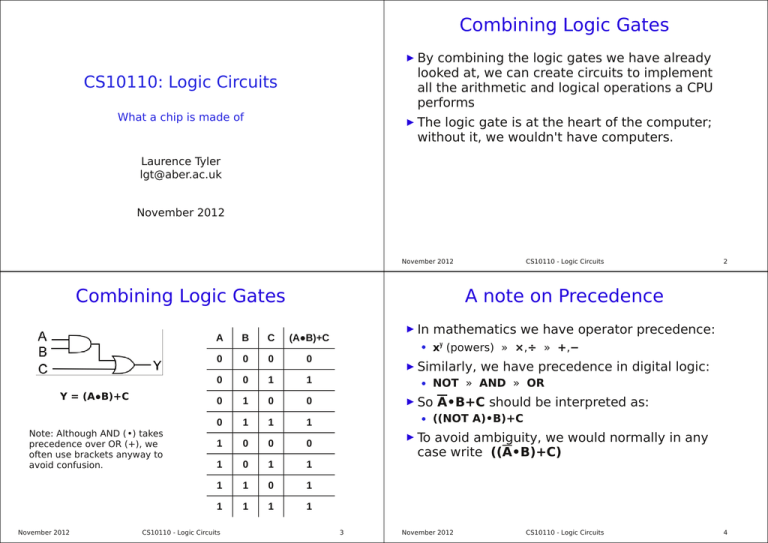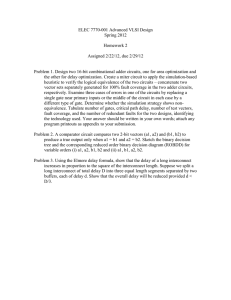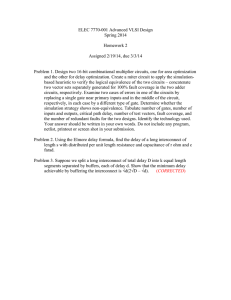Combining Logic Gates Combining Logic Gates A note on Precedence
advertisement

Combining Logic Gates ► By combining the logic gates we have already looked at, we can create circuits to implement all the arithmetic and logical operations a CPU performs CS10110: Logic Circuits What a chip is made of ► The logic gate is at the heart of the computer; without it, we wouldn't have computers. Laurence Tyler lgt@aber.ac.uk November 2012 November 2012 Combining Logic Gates Y = (A●B)+C Note: Although AND (•) takes precedence over OR (+), we often use brackets anyway to avoid confusion. November 2012 2 A note on Precedence A B C (A●B)+C 0 0 0 0 0 0 1 1 0 1 0 0 0 1 1 1 1 0 0 0 1 0 1 1 1 1 0 1 1 1 1 1 CS10110 - Logic Circuits CS10110 - Logic Circuits ► In ● mathematics we have operator precedence: xy (powers) » ×,÷ » +,− ► Similarly, ● NOT » AND » OR ► So ● we have precedence in digital logic: A•B+C should be interpreted as: ((NOT A)•B)+C ► To avoid ambiguity, we would normally in any case write ((A•B)+C) 3 November 2012 CS10110 - Logic Circuits 4 De Morgan's Theorem De Morgan's Theorem Consider the following circuit: Y = A∙B A B Y 0 0 0 0 1 1 1 0 1 1 1 1 A∙B = A+B A+B = A∙B ► This is a very useful rule to remember when trying to simplify a complex logic circuit ► We don't need an OR gate, because we can construct one using NAND and NOT gates ► We don't need an AND gate, because we can construct one using NOR and NOT gates What do you notice? November 2012 CS10110 - Logic Circuits 5 November 2012 Doing away with Gates 6 NAND and NOR ► We know we don't need an OR or an AND gate, because we can construct them from NOR, NAND and NOT gates ► But CS10110 - Logic Circuits ► So all we really need is NAND and NOR ► But, if we can construct an OR from NAND gates, we can construct a NOR too what about this: ● simply by inverting the output ► Similarly, November 2012 A Y A Y CS10110 - Logic Circuits if we can construct an AND from NOR gates, we can construct a NAND as well A Y 0 1 ► So 1 0 ► We we only need ONE type of gate: either a NAND or a NOR gate can then construct any logic circuit we want! 7 November 2012 CS10110 - Logic Circuits 8 Why use only one or two gates? NAND is simpler than AND ► There is a good reason why we should only want to use one or two types of gate - we don't just do this to make logic hard to learn! A 2-input NAND gate implemented in TTL logic Image courtesy of Wikipedia ► It is easier and cheaper to manufacture chips with only one or two types of gate on them ● ● Arrays of identical circuit elements Function actually determined by interconnection layer(s) - the metal "wiring" between gates NB: you are not expected to learn this circuit! For information only. ► Automated design systems can help with doing the required logic transformations to use a standard gate type November 2012 CS10110 - Logic Circuits Because of the way TTL (transistor-transistor logic) works, a NAND gate only needs two transistors. To make an AND gate we actually have to add another transistor to invert the output. 9 November 2012 Other Simplifications CS10110 - Logic Circuits 10 More complex circuits This is called Boolean Algebra 1) (A•B)+B = B 2) (A+B)•B = B 3) (A•B)+B = A+B 4) (A+B)•B = A•B 5) (A•B)+(A•C) = A•(B+C) 6) (A+B)•(A+C) = A+(B•C) Also note that, as in maths: Note: sometimes the • (AND) symbol is omitted, so AB means the same as A•B Note: the dot means the lines connect here. If there is not a dot, the lines do not connect but pass over each other. A•B = B•A A+B = B+A Doesn't matter which way round the inputs are (commutative rule) A•(B•C) = (A•B)•C A+(B+C) = (A+B)+C Doesn't matter how you group the brackets if it's the same function (associative rule) November 2012 CS10110 - Logic Circuits 11 Q: Work out expressions for Y0 ... Y4 November 2012 CS10110 - Logic Circuits 12 Complex circuit simplified ► Y0 = A•B ; Y1 = B+C ► Y2 = Y0+B The final circuit! A = (A•B)+B = A+B ► Y4 = A•B B Y3 = Y1•B = (B+C)•B = B•C ► (rule 3) C (rule 4) Y4 = Y2+Y3 = (A+B) + (B•C) = (A+B) • (B•C) = (A•B) • (B+C) (De Morgan's) (De Morgan's) = A•(B•(B+C)) (associative rule) = A•B (rule 2) November 2012 CS10110 - Logic Circuits As you can see, it's much simpler than what we started with - and we've shown that input C is completely redundant! 13 What next? ► If you can work your way through the values of Y0 to Y3 on the previous slides and write out expressions for them - without looking at the answers - and also understand the working for Y4, then you've conquered logic circuits, at least as far as this module is concerned! ► Find ● ● ● a logic simulator and try out some circuits: http://smartsim.org.uk/ (free, Win/Linux/Mac) http://sourceforge.net/projects/cedarlogic/ (free, Win) http://logic.ly/ (pay, but has online flash demo) ► If you're really keen, get a breadboard & some chips and make some real circuits... November 2012 CS10110 - Logic Circuits 15 November 2012 CS10110 - Logic Circuits 14

